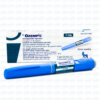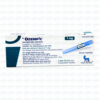The 2x Referral Bonus Event Is Now On! More Info ➡️
Home » Medication » Ozempic » Ozempic (Semaglutide) Injection
SAVE 10% OFF First Order With Coupon Code: WELCOME10



Our Price: $419.99

Step 1
Place Your Prescribed Ozempic 4mg Pen(s) Dosage In Your Cart
Step 2
Complete Checkout
Step 3
Upload Your Ozempic 4mg Pen(s) Prescription
(Shipping takes approximately 4-10 business days. A tracking number will be provided)
When you buy Ozempic online from Canada through Insulin Outlet, you’re gaining access to a wonderful resource. You’ll get the same quality assurance and adherence to federal standards practiced by American pharmacists but at a lower cost.
Approved by Health Canada (Canada’s approach to Federal Drug Administration), you can rely on Ozempic from Insulin Outlet to be a 100% authentic medication rather than a counterfeit. However, you’ll get it at a discounted price and can order from the comfort of your own home, and have it shipped to your door.
Ozempic is a prescription medication used for the management of type-2 diabetes in adult patients. It serves mainly to manage blood sugar, though its ability to help regulate appetite has shown promise in the field of weight management as well.
The active ingredient of this medication is semaglutide, which is used in several other types of medications as well. It works by mimicking a naturally-occurring hormone (generally referred to as GLP-1).
GLP-1, or Glucagon-Like-Peptide-1, is one of the hormones responsible for stimulating insulin production. By mimicking this hormone, semaglutide can trick your body into creating more insulin than it generally would, resulting in lower blood sugar levels.
The primary use is in the treatment of type 2 diabetes. Ozempic plays a valuable role in lowering and controlling blood sugar levels, which is essential in the management of diabetes.
This medication has also shown some promise in the treatment and prevention of cardiovascular disease. In certain patients, semaglutide may reduce the risk of major heart-related events.
While not an approved use for this particular type of semaglutide medication, Ozempic may also sometimes be used for weight loss. For the same reasons that it serves to help treat diabetes, Ozempic helps with appetite suppression and controlling blood sugar levels in the chronically obese.
Semaglutide (Ozempic’s active ingredient) works as a GLP-1 receptor agonist and mimics naturally occurring gut hormones to accomplish several things.
It helps to stimulate insulin production, which plays a valuable role in controlling high blood sugar. It also slows down digestion and reduces appetite, which plays a significant role in the control of blood sugar.
Finally, this medication prevents the liver from producing too much glucose, an essential part of controlling blood sugar.
Administering Ozempic
Ozempic should be taken once weekly and on the same day each week.
However, if you miss a dose, take it as soon as possible within five days of the missed dose. If more than five days pass after missing a dose, wait till the next dose instead.
Before using a new Ozempic pen for the first time, store it in the refrigerator. Do not place the pens in the back of the refrigerator, where they may freeze.
After the first use, you may store the pens at room temperature or continue to keep them in the refrigerator.
When you buy Ozempic online from Canada, ensure that you order the correct dose. You can choose from 0.25mg, 0.5mg, 1mg, or 2mg doses.
Typically, your primary care physician will start you at a 0.25mg dose for four weeks. They will then elevate your dose to 0.5mg for a minimum of four weeks. After this time, they may reassess and decide to increase your dose again.
It is critical that you use only the prescribed dose. There are no benefits to using a larger dose than you have a prescription for and doing so may exacerbate side effects or cause new side effects.
As with any medication, there is some vital safety information of which you should be aware.
Ozempic has several potential side effects. Mild effects include:
More severe effects include:
These conditions may manifest as dizziness, moodiness, headaches, stomach pain, and even sweating and slurred speech. If you experience any symptoms, contact your physician.
Ozempic may interact negatively with several other medications, specifically:
Ozempic has proven more effective than many other diabetes treatments, both in terms of A1C reduction and weight loss. This table compares the effectiveness of Ozempic when compared to competitors:
